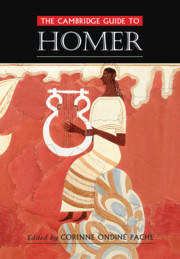Book contents
- The Cambridge Guide to Homer
- The Cambridge Guide to Homer
- Copyright page
- Contents
- Figures
- Notes on the Contributors
- General Introduction
- Part I Homeric Song and Text
- Introduction
- Homeric Epic in Performance
- Homeric Poetics
- Homer in a World of Song
- Epic Traditions
- Mythic Background
- The Language of Homer
- From Song to Text
- Key Topics
- Part II Homeric World
- Part III Homer in the World
- Bibliography
- Index
- References
From Song to Text
from Part I - Homeric Song and Text
Published online by Cambridge University Press: 22 February 2020
- The Cambridge Guide to Homer
- The Cambridge Guide to Homer
- Copyright page
- Contents
- Figures
- Notes on the Contributors
- General Introduction
- Part I Homeric Song and Text
- Introduction
- Homeric Epic in Performance
- Homeric Poetics
- Homer in a World of Song
- Epic Traditions
- Mythic Background
- The Language of Homer
- From Song to Text
- Key Topics
- Part II Homeric World
- Part III Homer in the World
- Bibliography
- Index
- References
Summary
This essay gives an overview of the transmission and reception of Homeric poetry from the early second millennium b.c. to the second century b.c. from a diachronic perspective. Over this period of time the Iliad and Odyssey developed out of a fluid tradition of oral composition-in-performance and crystalized into the poems we now know, shaped by a variety of forces, including the regulated performances of the Panathenaic festival in Athens. In the earliest phases of this tradition there were no written texts, but during the period examined here, textualization occurs ‒ first in the form of transcripts of performance, then in the form of scripts ‒ before the poems finally achieve a status not unlike scripture. Even in the second century b.c., however, no single version of the text of these poems could be considered canonical, with the result that a multitextual approach is needed for the interpretation of Homeric poetry.
- Type
- Chapter
- Information
- The Cambridge Guide to Homer , pp. 80 - 96Publisher: Cambridge University PressPrint publication year: 2020



